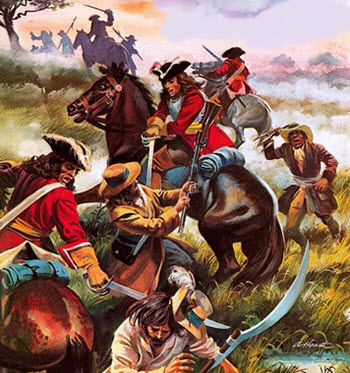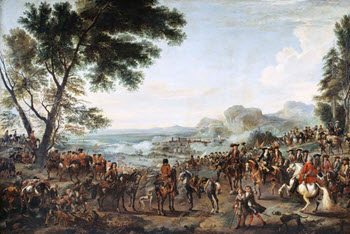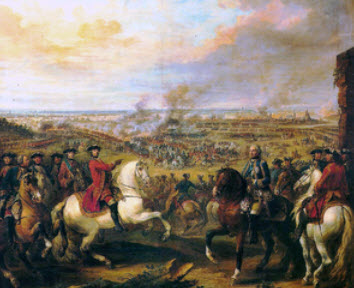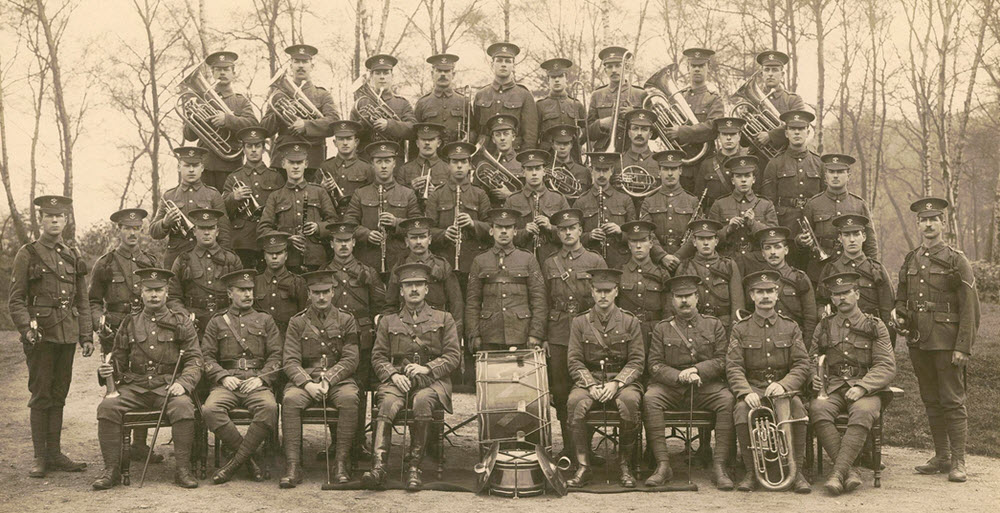Contents
The Somerset Light Infantry (Prince Albert’s) was a light infantry regiment of the British Army, which served under various titles from 1685 to 1959. It would take quite a long time before it began using the name Somerset Light Infantry – it started out as the Earl of Huntingdon’s Regiment of Foot.
The Monmouth Rebellion
 When king Charles II died in 1685, his younger brother was crowned James II – despite being a Roman Catholic. Protestants who opposed a catholic king put forward James Scott, 1st Duke of Monmouth, as the rightful heir to the throne, despite the fact that he was an illegitimate son of Charles II. Their attempt to overthrow James II and install a protestant on the throne is known as the Monmouth Rebellion, The Revolt of the West and The West Country Rebellion.
When king Charles II died in 1685, his younger brother was crowned James II – despite being a Roman Catholic. Protestants who opposed a catholic king put forward James Scott, 1st Duke of Monmouth, as the rightful heir to the throne, despite the fact that he was an illegitimate son of Charles II. Their attempt to overthrow James II and install a protestant on the throne is known as the Monmouth Rebellion, The Revolt of the West and The West Country Rebellion.
As a response to the Monmouth Rebellion, James II expanded the size of his army – including the creation of nine regiments of foot. On 2 June 1685, Theophilus Hastings, 7th Earl of Huntingdon was issued a royal warrant authorising the earl to raise a regiment. The earl chiefly recruited men from the county of Buckinghamshire and created Earl of Huntingdon’s Regiment of Foot. This was the regiment that would eventually become the Somerset Light Infantry.
The Jacobite Wars
Three years after the formation of Earl of Huntingdon’s Regiment of Foot, the Glorious Revolution placed the protestant William III on the throne. Fernando Hastings took over the colonelcy of the Huntingdon’s regiment, and it thus became Hasting’s Regiment of Foot.
 The Jacobites wished to return the catholic James II to the throne of Great Britain, and this resulted in the Jacobite Wars. In 1689, Hasting’s Regiment of Foot was employed to combat Jacobite forces in Scotland. At the Battle of Killiencrankie, the Highland charge of the Jacobites took the government forces by surprise and overwhelmed them in 10 minutes, but one of the most famous leaders of the Jacobite uprising – John Graham of Claverhouse – was killed.
The Jacobites wished to return the catholic James II to the throne of Great Britain, and this resulted in the Jacobite Wars. In 1689, Hasting’s Regiment of Foot was employed to combat Jacobite forces in Scotland. At the Battle of Killiencrankie, the Highland charge of the Jacobites took the government forces by surprise and overwhelmed them in 10 minutes, but one of the most famous leaders of the Jacobite uprising – John Graham of Claverhouse – was killed.
The government forces failed to halt the advance of the Jacobite forces at Killiencrankie, but the Jacobites were later defeated at the Battle of Dunkeld.
In the following year, Hasting’s Regiment of Foot was sent to Ireland to fight at Boyne and Cork.
The Nine Year’s War
 The Nine Year’s War (1688-1697) was a major conflict between Louis XIV of France and a European-wide coalition of Austria and the Holy Roman Empire, the Dutch Republic, Spain, Britain, and Savoy.
The Nine Year’s War (1688-1697) was a major conflict between Louis XIV of France and a European-wide coalition of Austria and the Holy Roman Empire, the Dutch Republic, Spain, Britain, and Savoy.
In 1692, Hasting’s Regiment of Foot set sail for Flanders, and in 1694 they participated in an amphibious assault at Camaret on the French coast. The assault was a disaster for the British.
In 1695, Fernando Hastings was found guilty of extortion and Sir John Jacob took over as colonel for the regiment. The regiment was now Jacob’s Regiment of Foot, and was to remain abroad until 1697 when the Nine Year’s War ended.
War of the Spanish Succession
 After the end of the Nine Year’s War, Jacob’s Regiment of Foot did garrison duty in Ireland before going back to Flanders in 1701. In 1702, their colonel retired and sold the colonelcy to his brother-in-law, Lieutenant-General James Barry, 4th Earl of Barrymore. The payment was 1,400 guineas.
After the end of the Nine Year’s War, Jacob’s Regiment of Foot did garrison duty in Ireland before going back to Flanders in 1701. In 1702, their colonel retired and sold the colonelcy to his brother-in-law, Lieutenant-General James Barry, 4th Earl of Barrymore. The payment was 1,400 guineas.
As the War of the Spanish Succession broke out in 1702, Earl of Barrymore’s Regiment of Foot participated in battles and sieges at Kaiserwerth, Venlo, Roermond, Huy, Limburg and Liège. In 1704, they travelled to the Iberian Peninsula to defend Gibraltar, and in the following year, the regiment aided in the Siege of Barcelona.
In 1706, the British forces were experiencing a shortage of cavalry and a majority of the men in Earl of Barrymore’s Regiment was turned into a regiment of dragoon. Only a small cadre remained with Barrymore, and returned with him to England to find new recruits before going back to Spain. In Spain, they fought four battles in five years.
- The Battle of Almanza (1707)
- The Battle of La Caya (1709)
- The Battle of Tortosa (1711)
- The Battle of St Mateo (1711)
After the battles of Tortosa and St Mateo, the regiment did several years of garrison duty at Gibraltar. By 1715, Barrymore was replaced by Stanhope Cotton, who was then replaced by Lord Mark Kerr in 1725. The regiment was thus known as Cotton’s Regiment of Foot and Kerr’s Regiment of Foot, respectively.
Anglo-Spanish War
In 1727, the Anglo-Spanish War broke out and Kerr’s Regiment of Foot had to resist a Spanish Siege of Gibraltar. The regiment returned to England in 1728. They became Middleton’s Regiment of Foot under Brigadier-General John Middleton in 1732 and Pulteney’s Regiment of Foot under General Harry Pulteney in 1739.
 War of the Austrian Succession
War of the Austrian Succession
In 1742, Pultney’s Regiment of Foot returned to Flanders to join a British-Hanoverian-Autrian force. This was the joint force that won over the French in the Battle of Dettingen in June 1743. Roughly two years later, Pultney’s Regiment of Foot was part of an army that was defeated by the French at the Battle of Fontenoy.
In the same year as the Battle of Fontenoy, Pulteney’s Regiment of Foot went back to Britain. The government needed them in Scotland, were Jacobites were rising. In January 1746, government forces – including Pulteney’s Regiment – were defeated at the Battle of Falkirk. But the Jacobite joy was short lived; just three months later they were defeated for good in Culloden, with Pulteney’s soldiers participating in the battle.
Once the Jacobite rising was squashed, Pulteney and his men went back to Flanders again. They participated in two unsuccessful battles against the French, one in Rocoux in 1746 and one in Lauffeld or Val in 1747. The regiment returned back to England in 1747 and in the following year the War of the Austrian Succession ended.

